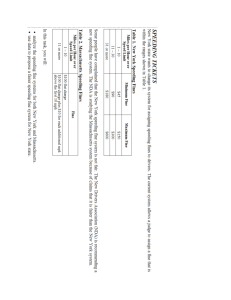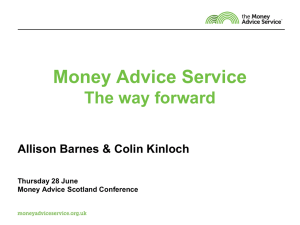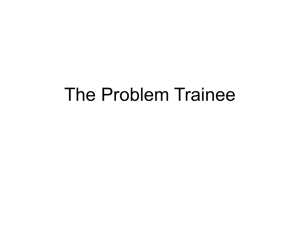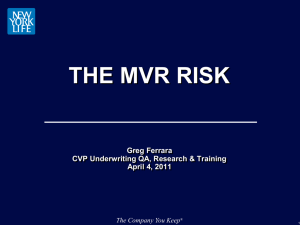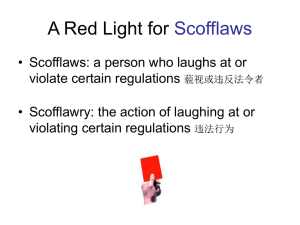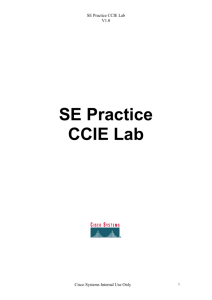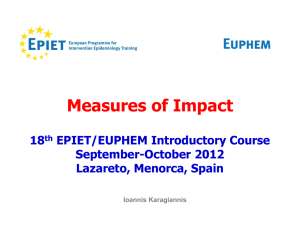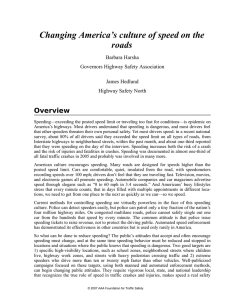presentation
advertisement
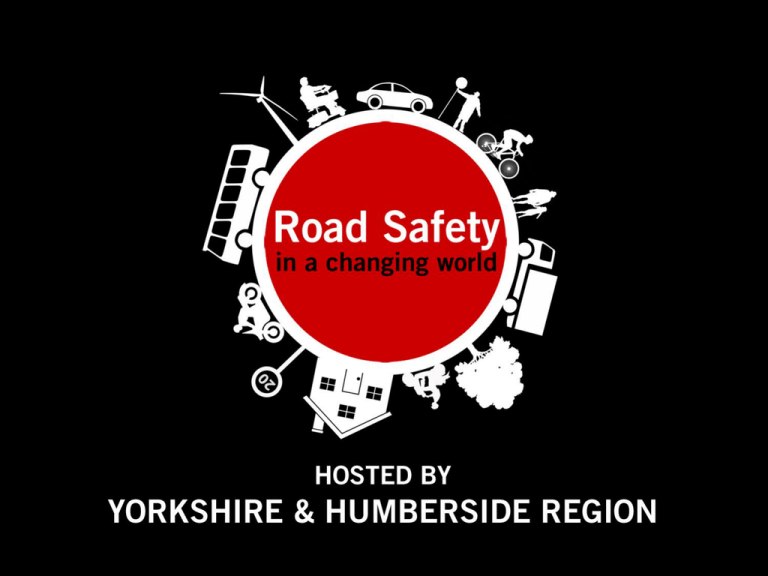
Dr Fiona Fylan Reader in Psychology Leeds Metropolitan University Sleepy, Dopey, Grumpy or Happy: Making the Speeder Snow White Sleepy, Dopey, Grumpy, or Happy: Making the speeder Snow White Fiona Fylan, Reader in Health Psychology Leeds Metropolitan University Beth Fylan Gwynn & Lauren Caveney Brainbox Research What influences speed? Attitudes Norms Selfidentity Personality Intention Are all speeding drivers the same? • • • • Sleepy Dopey Grumpy Happy Sleepy • Unaware of the limit • Underestimate speed • Lapse of attention Dopey • Perceive themselves as safe and skilled. • Believe they speed only a little over the limit. • Speed less frequently than high speeders. • Don’t experience pleasure from speeding. Grumpy • Aware they drive faster and they’re at increased risk but believe they are safe. • More positive attitude to speeding and they speed more frequently. • Experience more pleasure and emotional outlet from driving. • Report more crashes/violations. Happy • Know their speed is dangerous: they enjoy taking risks and breaking rules. • More likely to drive dangerously and break the law in other ways. • Younger, high on psychoticism and thrill seeking, low on neuroticism. • Some “grow out if it” by age 26. Making the speeders Snow White Integrated driver model (Fylan 2011) Norms Driver responsibility Barriers Risks Attitudes Intention Behaviour Consequences Skills Self-identity Emotions 27 Driver BCTs (Fylan and Stradling) Information Agreeing Monitoring Teaching Supporting Managing Planning Implementing Feeling Good Does the speed awareness course achieve its objectives? How and why does it do so? Survey with 2070 clients 15 providers Six focus groups 28 participants 13 females, 15 males 4 providers, 2 course types Data collection and analysis • Random selection of clients invited to participate in focus groups. • They had attended a course 3-12 months previously. • Focus groups lasted around 90 minutes. • We took a critical realist approach and undertook an inductive thematic analysis (Braun and Clarke, 2006) • One researcher coded the data and a subset of the transcripts were analysed independently by a second researcher. All three researchers reviewed the themes. Intentions to comply with speed limits No such shift in intentions for speed offenders in areas where there are no courses. Challenging attitudes Giving insight Enabling application advantages of speeding own driving skills in identifying limits driving environment own pressures driving tips need for speed limits limits of knowledge become an advocate Challenging attitudes: advantages of speeding He [the tutor] said about if you drive, say if you’re driving to work and you break the speed limit, that it was just a few minutes that you gained, it was so little. I think that as well, there was no point in speeding, just for a minute, what’s the point? You know, so that stuck in my mind. [FG5] He just said “If you drive within the limit you can forget about speed cameras, it doesn’t matter, they’re irrelevant”, and that was the bit I picked up. So I try and drive within the speed limit and within the appropriate speed in the conditions, you know. [FG4] But it’s not all good news I think because we are not bad drivers we speed responsibly, in other words that you’re still very aware of what you’re doing: you’re not on the phone or texting or with no seatbelt on or driving recklessly when there’s parked cars, you’re not doing 40 slaloming round. It’s speeding responsibly which means you’re doing slightly over the limit but you feel safe and confident and responsible still at that speed. I don’t think any of us have been going so fast that we’re not in control. [FG1] Challenging attitudes: driving environment I think it was a lot of the statistics that they used and, you know, the mortality rates on roads that are round where we live that you would never have realised that it was that high, and it was like – God! [FG6] I remember the sheets we had had pictures and you had to come up with all the different hazards and whatever else that were on there and it was good working together. [FG1] Challenging attitudes: need for speed limits When I notice that I’m going 35 or something in a 30 mile limit I just slow down whereas before I thought it doesn’t matter, it’s not that fast. [FG2] The thing that made a really big difference to my thinking was looking at the mortality rate at the speed you are travelling and how much it comes up between 30 and 40, I mean there is a really good reason why you should stick to 30, I mean most people there have been caught doing a little bit over 30, that was the case for me, there is a really good reason to stay below 30 because the mortality rate group just shoots up exponentially between those two speeds and that really pound it home for me. [FG5] Giving insight: own driving I must admit before I tended to drive a lot, unfortunately, under remote control, you just get into the car and you drive and you think nothing of it, in fact you’re not even concentrating on what you’re doing. That’s the danger, you just become very over-confident in your abilities, so it has opened my yes. [FG4] It gives you the time to reflect, to have some time to reflect on things and discuss things in an adult way. [FG3] It does make you think “Where else am I speeding?” You know, it brings it home to you that you’re obviously doing it without even realising that you’re doing it. [FG5] Giving insight: own pressures It’s that mentality, isn’t it: you’ve got to be in front, got to be in front, got to be in front. I just sit back now. My drives to work are far more relaxed now than they ever used to be. I just watch people go by: just like “You get on with it – I’m not getting to work stressed”. [FG 1] Things happen when you have to speed, like when you’re on the motorway and you’re overtaking and they suddenly speed up, what do you do? There are certain types of situation where at one time it would be foot down. You know, I’d race against the clock at one time, but now I don’t. [FG2] Giving insight: limit to knowledge It was quite shocking, how little you know, personally, how little of those road signs I was aware of, what they really meant. [FG3] I thought I knew everything but I didn’t; I knew very little. [FG2] Enabling application: skills in identifying limits He [the tutor] highlighted different speed limits and just like going down a country lane with no street lights I would have been looking for signs to say what the speed limit is if I hadn’t noticed at the beginning it was a national speed limit but he told me that if there’s not street lighting and no repeaters it’s automatically a national speed limit. There was a lot of information that he gave me that I found very useful and it has made me a lot more aware of speeds and where the signs are to see what speeds you should be at. [FG5] Enabling application: driving tips I think I drove so fast ‘cos I’m a bit bored, just want to get there quickly. Now I’ve got something else to concentrate on while I am driving like reading the road ahead, thinking about the speed limit, thinking about what the dangers are. I’m much more engaged with the activity and I am gong to do it better and I like to do things well, so that appealed to me. [FG3] I sort of drive down the road and I see things and it prompts back to perhaps something I’ve remembered from the course, you know even sort of writing in the road and such. And you see other people making mistakes and you think “You’re doing that wrong.” You sort of become very critical of other people. [FG6] Enabling application: becoming an advocate I’ve sat in a car with my partner many a time and said “Do you know this?” and he’s like “I feel like I’ve been on the course.” [FG6] I always find now that I stay a lot further away from cars, and even if I’m sat in my girlfriend’s car I’m like “What’s the need for that? Get back!” [FG4] Conclusions • Theory-led, evidence-based behavioural change interventions can change how people (intend to and report they) drive. • The NDORS Speed Awareness Course increases intentions to drive within the speed limit by challenging attitudes, giving insight, and enabling application. • Interventions should be designed using BCTs so that the “active ingredients” are defined and that delivery is consistent. • BCTs can help us build an evidence base about how best to change driver behaviour. Thank You Dr Fiona Fylan Reader in Psychology Leeds Metropolitan University f.fylan@leedsmet.ac.uk Beth Fylan Gwynn, Lauren Caveney Brainbox Research, 0113 238 0157 info@brainboxresearch.com www.brainboxresearch.com
